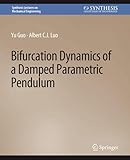Bifurcation Dynamics of a Damped Parametric Pendulum [electronic resource] / by Yu Guo, Albert C.J. Luo.
By: Guo, Yu [author.] .
.
Contributor(s): Luo, Albert C.J [author.] | SpringerLink (Online service)
| SpringerLink (Online service) .
.
Material type:  BookSeries: Synthesis Lectures on Mechanical Engineering: Publisher: Cham : Springer International Publishing : Imprint: Springer, 2020Edition: 1st ed. 2020.Description: XIV, 84 p. online resource.Content type: text Media type: computer Carrier type: online resourceISBN: 9783031796456.Subject(s): Engineering
BookSeries: Synthesis Lectures on Mechanical Engineering: Publisher: Cham : Springer International Publishing : Imprint: Springer, 2020Edition: 1st ed. 2020.Description: XIV, 84 p. online resource.Content type: text Media type: computer Carrier type: online resourceISBN: 9783031796456.Subject(s): EngineeringPreface -- Introduction -- A Semi-Analytical Method -- Discretization of a Parametric Pendulum -- Bifurcation Trees -- Harmonic Frequency-Amplitude Characteristics -- Non-Travelable Periodic Motions -- Travelable Periodic Motions -- References -- Authors' Biographies.
The inherent complex dynamics of a parametrically excited pendulum is of great interest in nonlinear dynamics, which can help one better understand the complex world. Even though the parametrically excited pendulum is one of the simplest nonlinear systems, until now, complex motions in such a parametric pendulum cannot be achieved. In this book, the bifurcation dynamics of periodic motions to chaos in a damped, parametrically excited pendulum is discussed. Complete bifurcation trees of periodic motions to chaos in the parametrically excited pendulum include: period-1 motion (static equilibriums) to chaos, and period-���� motions to chaos (���� = 1, 2, ···, 6, 8, ···, 12). The aforesaid bifurcation trees of periodic motions to chaos coexist in the same parameter ranges, which are very difficult to determine through traditional analysis. Harmonic frequency-amplitude characteristics of such bifurcation trees are also presented to show motion complexity and nonlinearity in such a parametrically excited pendulum system. The non-travelable and travelable periodic motions on the bifurcation trees are discovered. Through the bifurcation trees of travelable and non-travelable periodic motions, the travelable and non-travelable chaos in the parametrically excited pendulum can be achieved. Based on the traditional analysis, one cannot achieve the adequate solutions presented herein for periodic motions to chaos in the parametrically excited pendulum. The results in this book may cause one rethinking how to determine motion complexity in nonlinear dynamical systems.


There are no comments for this item.